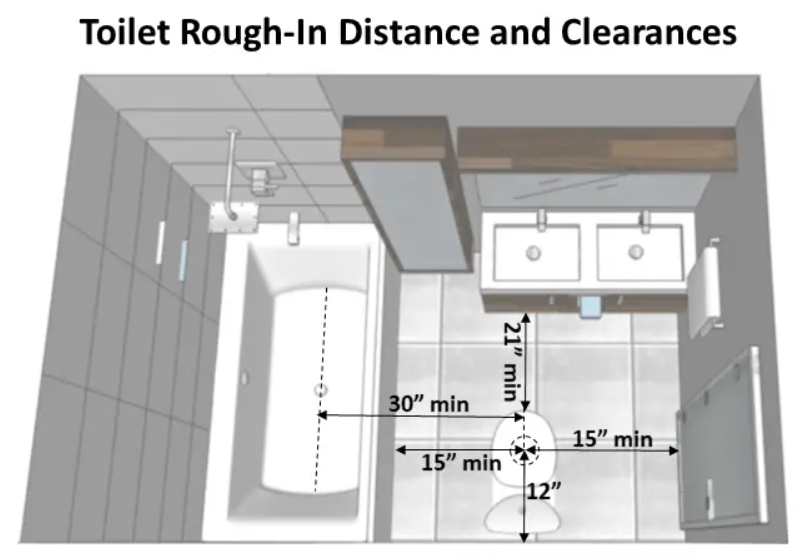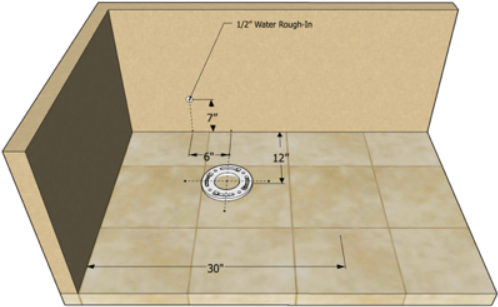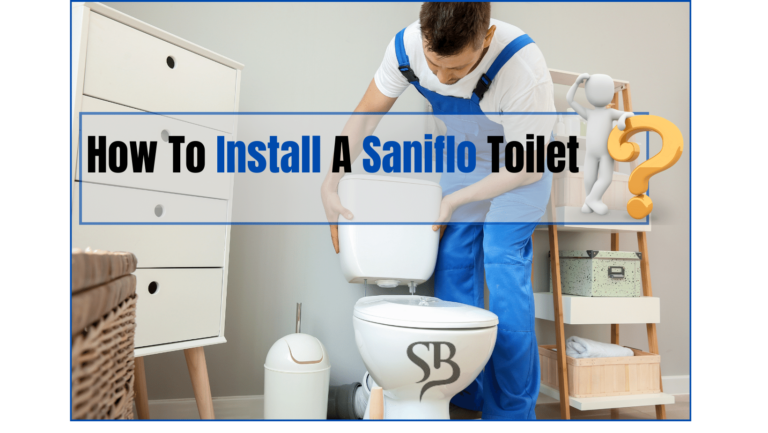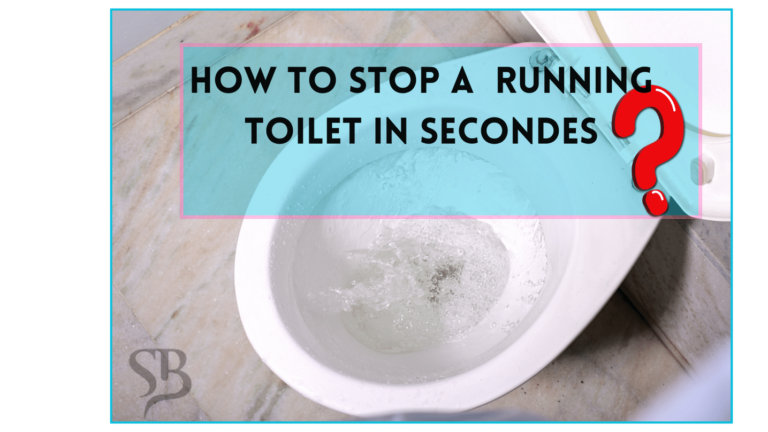The placement of a toilet inside a bathroom is a crucial architectural and functional factor. The proximity between the wall and the toilet is vital when positioning it in this location.
This design’s spatial layout is essential for comfort and convenience and must also adhere to building regulations, accessibility standards, and plumbing needs.
Positioning toilets about walls is crucial in establishing a comfortable and appropriate restroom in any building, whether a private home, commercial establishment, or public facility.
This study examines the intricate variables determining the optimal toilet distance from wall.
Standard Measurements
Installing a toilet and bidet in a bathroom requires 18 inches from the midline to the closest wall, fixture, or impediment.

Code requires fifteen inches between the centerline of a toilet and any other institution, wall, or block in a bathroom.
The standard toilet measurements are 28-30″ in depth, 20″ in width, 27-32″ in height, and 10-14″ in rough-in. The ideal toilet is now within your reach.
Also read: Why Is My Toto Toilet Making Noise After Flushing
Architectural Standards and Laws
If you live or work in these structures, you need laws to protect them from damage.
People may feel comfortable in their homes, places of employment, and vacation spots when they follow the rules.
Compliance with construction regulations is essential for all parties involved in the market for property, including sellers and landlords.
Accessible Design
The specified dimensions for these storage spaces are 60 inches in depth and 35–37 inches in width.

Restrooms must have toilets positioned on the room’s rear wall, with the toilet’s centerline being 17 to 19 inches away from any wall or barrier. As part of the design, a grab bar should be on each bathroom side.
A handicapped-accessible bathroom needs usually measures 60 by 56 inches to accommodate fittings.
Additional fixtures and door swings demand more space and a larger bathroom. ADA needs no room measurements.
Also read: The Surprising Benefits of Placing a Red Cup Under Your Toilet Seat
Plumbing Consideration
The clearance between a toilet and a wall is a crucial element that impacts the installation, maintenance, and repair of the fixture in plumbing.
Ample space around the bathroom is vital for several plumbing purposes, such as ensuring optimal functionality and facilitating effortless maintenance.
Required Installation Materials
Installation requires appropriate space behind and around the toilet. To connect the bathroom to the water supply, sewer line, and floor, plumbers need space to manoeuvre.
The distance from the wall determines the bathroom-to-waste pipe flange location. Misalignment during installation might cause leaks or functioning issues.
Also read: Is Flushing While Sitting on the Toilet Safe?
DIY Installation
If you’re planning on installing or restoring your toilet on your own, here’s a comprehensive guide on finding and keeping the proper distance between the bowl and the wall:
- Proper tools for measurement
- Writable material
- Level
- For some setups, you may need an adjustable wrench or pliers.
- Sink flange
- Enamel ring
- Parts for fastening toilets
- Optional: sealing the toilet
Also read: How to Get Rid of Tiny Air Bubbles in Toilet Bowl
How to Measure the Proximity of a Toilet to a Wall
Make Sure Everything Is Clear
You have to Empty the area around the toilet in the bathroom. Remove the old one if you are remodeling or getting ready to install a new toilet.

Get an Approximate Interval
An essential measurement is the rough-in distance, which is the distance from the wall to the middle of the drain pipe for the toilet. Precisely measure this distance.
Bathrooms may have varying requirements, with some requiring 10 or 14 inches of rough-in compared to the more common 12 inches.
Also read: Troubleshooting American Standard Touchless Toilet Problems
Locate the Area on the Floor
Please indicate the spot on the floor where the centre of the toilet drain pipe will be positioned using the measured rough-in distance. Get out your pencil or marker and create that mark.
Verify Authorization.
Make sure there is enough room around the chosen restroom. For a toilet to be used comfortably, you should provide fifteen inches of space on each side and twenty-four inches in front of it.
Place the Flange
Cover the floor’s indicated centre with the toilet flange. Check that it fits snugly and lines up with the rough-in measurement. The toilet’s flange attaches to the tubing from the drain.
Fasten the bolts and wax ring.
A wax ring may seal the toilet to the drain by inserting it into the flange. Once you’ve ensured the bathroom is level, you can fix it by inserting the bolts into the flange slots.
Also read: How Long Should a Roll of Toilet Paper Last?
Adjust the Lavatory
Bring the toilet down onto the flange, ensuring the bolts are correct. The wax ring may be set and sealed with a light press. Before flushing the toilet, use a level to check that the bowl is flat.
Make Sure the Bowl Is Secure
Fasten the nuts onto the bolts and turn them so they’re snugly snug against the toilet. Take care not to overtighten, as it might cause harm to the bathroom.
Establish Linkages
Switch on the water supply to locate leaks and attach the pipe to the toilet’s input valve. To make sure it’s working correctly, test the flushing mechanism.
Caulk (Optional)
To make it seem complete and stop water from leaking beneath the toilet, you may put a thin bead of caulking around its base if you choose. Be careful not to obstruct the toilet’s weep holes at the bottom.
Also read: How Do You Measure Corner Toilet Rough-In Dimensions?
Mistakes to Avoid on Toilet Distance from Wall
Be sure to provide at least 20 cm of elbow space on each side of the toilet when you arrange its placement.
A typical error amateur remodelers make is putting downlights above the vanity, shower, or bathroom instead of using several light sources.

Also read: Who Makes Woodbridge Toilets, and Where are They Made?
Putting the Toilet in the Wrong Place
The toilet invariably finds itself in an inconvenient location whenever a bathroom is remodelled. At the moment of entry, it ought to go unnoticed.
Keep your distance from any nearby bathrooms when you leave the entrance to the restroom ajar.
Conversely, it’s unacceptable to hide the toilet to the point where it becomes jammed between cupboards and walls, making it hard for people of a higher or more considerable stature to use it.
Solution To Putting the Toilet in the Wrong Place
To ensure the toilet is out of sight whenever you open the door to the bathroom, tuck it behind the door or set it aside to the side.
You should leave at least 20 centimetres of space on each side of the toilet while arranging its placement.
Putting things in that are too big for the room.
Not all home improvement enthusiasts are limited to small bathrooms. A well-designed bathroom will have plenty of areas for people to walk about and use.
Therefore, that stunning standalone tub may be lovely but not practical for your bathroom.
Also read: What Happens If You Flush a Frog Down the Toilet?
Solution To Putting things in that are too big for the room.
Make sure the size of your bathroom is appropriate for the tub, vanity, and shower.
If you insist on a standalone tub, measure the area carefully to ensure it will fit and that there is enough clearance for cleaning.
Consider a more oversized inset bath, or do away with the tub and install a spacious, frameless shower to use the available space efficiently.

Also read: Push Button Toilet Flush Problems and How to Fix Them
Avoiding dimensional verification
This error, which may lead to significant issues and needless expenditure, is becoming more typical as the number of people ordering things online continues to rise.
Solution To Avoiding dimensional verification
To ensure accurate measurement, you must examine the product’s line drawing and physical form.
For instance, pay attention to the outlet length as it passes over the bath and the basin; if it’s too short, it won’t just look bad, but it will also cause splashing and maybe make it impossible to wash your hands in the basin.
Getting the tapware at the last minute
Putting off getting the tapware is another typical blunder.
Solution To Getting the tapware at the last minute
Making a selection early ensures you won’t panic when the plumber requires the product, which might delay the job, as the in-wall portion of the items must be put in early on.
Also read: Choosing the Right Size Allen Wrench for Your Toilet Paper Holder
Final thoughts
In conclusion, toilet distance from wall might be seemingly unimportant, but it is the area between a toilet and a wall that has a crucial role in the functionality and design of a bathroom.
An optimal toilet placement inside a room has implications beyond aesthetics, including plumbing, comfort, maintenance convenience, and accessibility.
It is also an essential factor to consider in compliance with building regulations and accessibility standards.
The optimal distance provides convenient accessibility for repairs and maintenance while enhancing user comfort and convenience, striking an optimum equilibrium between aesthetics and practicality.
Also read: How to Fix Common Saniflo Toilet Problems







